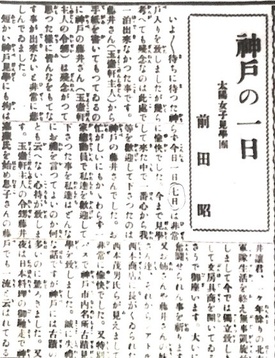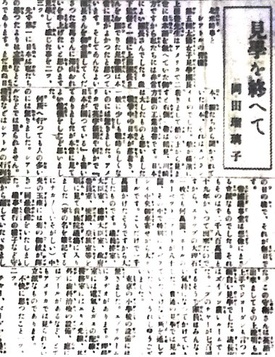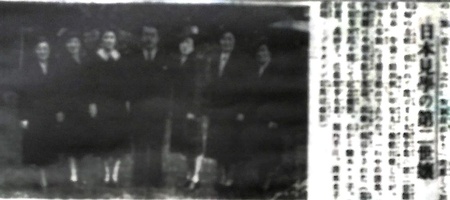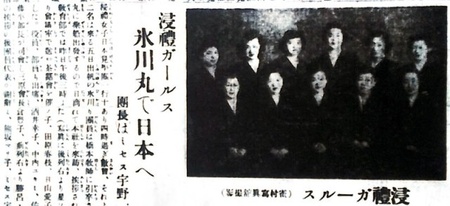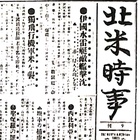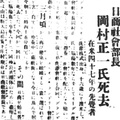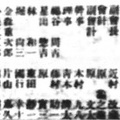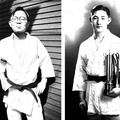Touring in Kobe on November 7, 1939
“A Day in Kobe, Taiyo Delegation” by Akira Maeda” (February 5, 1940 issue1)
We visited several locations in Kobe city, touring well-known historical sites by bus that were specifically arranged for us. I was surprised to find that Kobe had so many historical sites. At night, we enjoyed a Japanese feast at Enmeitei, which is a restaurant that many would call top-tier in Kobe.
After dinner we boarded the Sansui-maru departing from Kobe at 11:30 pm and headed straight to Tokushima. We were sent off with people calling “Taiyo Group Banzai” as if sending soldiers going to war.
Touring in Shikoku around November 8 and 9, 1939
“Taiyo Delegation in Tokushima and Takamatsu” by Akira Maeda (February 8, 1940 issue)
We boarded the ship from Kobe in its second-class carriage. The delegation seemed worried about having to sleep there, as there were more males than females. They only slept about two hours.
We arrived in Tokushima around 5 a.m. the following morning. We first visited the Tokushima city hall and met Mayor Kudo as well as Governor Araki. We went to Ushijima Island, the hometown of Banzo Okada, who is the founder of Taiyo Girls Club. Then we headed to Takamatsu by steam train. At Takamatsu Station, the number of people waiting for us was of a record-breaking level for welcoming individuals. The next day we visited Kanoji Temple and Yashima.
It seemed that the Taiyo Girls traveled from Shikoku to the mainland after this. They toured Okayama as their last destination and where then dismissed to head to their parents’ hometowns.
One of the members of the Japan Delegation, Miss Ruriko Okada, published and expressed her thoughts on her visit to Japan.
“After the Visit” by Ruriko Okada (December 29, 1939 issue)
To The North American Times and Seattleite
Mr. Yutaka Ueda who led the fifth delegation was an excellent leader as he had experience teaching Japanese to Nisei in the U.S. We, as a group, were so lucky to have Mr. Ueda lead us. And I’m also grateful to The North American Times President, Mr. (Sumiyoshi) Arima for arranging such a great leader. I’d like to share a few thoughts I had on the tour.
First of all, Japan was more modernized than we thought. The Japan that we had not seen, the Japan that we had heard about from our parents, was fascinating. When we arrived in Yokohama, we were topside of the ship seeing the industrial district of the Tsurumi and Kawasaki areas. I thought that Japan was an amazing place.
Despite its ongoing conflicts, Japan seemed calm. I was surprised to see that, for the most part, the country didn’t look like it was entangled in war. In the states, the American news circuit had been reporting things like “Japan’s in trouble.” So, I truly think I learned a lot by seeing the place myself.
I was surprised that everywhere we visited was packed with people. That’s not something we see in Seattle. The trains were crowded like the busiest days in Seattle, but that’s just an everyday scene here.
The Imperial Diet Building was more magnificent than I had imagined. We visited the Diet Members’ Waiting Room, ministers’ rooms, the Prime Minister’s Office, the House of Peers and other places. . . .
The facilities at elementary schools in Tokyo were amazing. They had a radio in every room. Science rooms had the wiring of electricity and gas, medical rooms had X-ray machines and equipment for dental treatment, and they had swimming pools in the yard – we cannot see anything as compelling as these in America.
Let me mention a few things I disliked. It was inconvenient that I had to adapt to tatami mats and futon from bed so unexpectedly. As for food, what was difficult for me was I had to eat sashimi on a number of occasions.
I teared up when we visited the hospital of soldiers in Tokyo. I felt so sorry for the healthy young men, who seemed to be around 24 or 25, when I saw that they had lost their limbs or became blind. Every morning and evening, I pray that their lives will be filled with happiness from now on. . . .
Seeing Japanese people bow and earnestly pray to gods made me feel foreign. . . .
I really liked the black uniform we wore. Everyone we met on our tour complimented our black suit. I was extremely lucky to experience Japan as a member of the delegation group. And I’m expressing my gratitude from the bottom of my heart to everyone who took care of us and to my parents, who let me join this tour. I would recommend that Nisei like us should definitely visit Japan at least once.
I’m getting permission to audit classes at a girls’ school, so I will commute 5 li (about 20 kilometers) a day by steam train from the countryside, where my parents were born, to the city of Tokushima, starting in January.2
By reading this article, we can see that Miss Ruriko Okada was fluent in Japanese, but she probably gained a new understanding of Japanese current events, culture, and customs through this tour.
We can also see clearly that the success of the Taiyo Delegation Group can be attributed to the great cooperation and support of those in Japan who accepted them and had lived in America like Sumikiyo Arima and the others.
“Welcoming the New Year by Miyoko Okazaki on Behalf of Taiyo Girls Club” (January 1, 1940 issue)
We the members of Taiyo Girls Club saw our older sisters off to Japan last fall as the Taiyo Delegation Group, and we grew from juniors to seniors now.
Looking back, our sister in the Taiyo Delegation Group left in September of last year. Many people expressed their worries and thoughts. But thanks to the support and help from the outstanding people of Japan, they were able to continuously learn throughout their tour. I wonder how they felt as they greeted the New Year.
There’s a plan for us to visit our beloved Japan as well in 1942. We’re looking so forward to this that we, the club members, are not wasting any money. We are saving every penny we get from our allowances and trying to work during school breaks to save as much as possible for our trip to Japan...
Our club members have a meeting every month and we trade off whose house we meet at. We’ve just become 15 or 16, but we would like to do something for our society.
Japan Tour Hosted by Shufuno-tomo-sha
Because of the success of the Taiyo Girls, Shufu-no-Tomo-Sha, a large publishing company in Japan, arranged a Japan tour for college-graduated American Nisei bachelorettes.
“Shufuno-tomo-sha Invites Nisei Girls” (January 15, 1940 issue)
In the hope of fostering individuals who will work for both Japan and the U.S. in the future, Ms. Waka Yamada has asked Mr. Banzo Okadaof Taiyo Club to choose 5 or 6 college-graduated Nisei women to come and tour Japan. They will leave on February 15 by the Heian-maru. They will recruit three from Seattle and two or three girls from Portland, Yakima, and other places.
“Nisei Girls Invited to Japan” (January 19 and 26, 1940 issues)
Four members have been selected. Shufuno-tomo-sha, four graduates from the University of Washington and two graduates from the University of Oregon are scheduled to set sail on February 23.
“The Name of the Delegation Group” (February 6, 1940 issue)
The name of Shufuno-tomo-sha’s Nisei girls delegation group has been decided as the “Shufuno-tomo Home Country Delegation Group of College Graduates.
“Nisei Bachelorettes’ Japan Tour” (February 23, 1940 issue)
Invited by Shufuno-tomo-sha, five college-graduated Nisei bachelorettes boarded the Heian-maru that set sail today at 2 PM. They had a grand departure with a large audience to see them off. Two girls in the group, Miss Shimizu and Miss Horiuchi, visited and greeted us this morning before departure.
Japan Delegation of Baptist Girls
The Seattle Japanese Baptist Church, which was founded in 1899, also formed a delegation group of Nisei girls around 1940, and the group went touring around Japan.
“The Baptist Girls Observation Group Boards the Hikawa-maru for Departure” (January 12 and February 24, 1940 issues)
Thirteen members of the Japan Delegation Group from the Baptist Church Girls Youth Club will attend the send-off banquet tomorrow on February 25, depart by the Hikawa-maru on March 4, and return to Seattle in late May. They are scheduled to visit military and navy hospitals.
“Baptist Girls Leave for Japan by Hikawa-maru” (March 2, 1940 issue)
Twelve members of the Baptist Girls Observation Group attended the send-off tea party that was hosted by the educational section of the Nihonjin-kai on March 1. The board members were present too. Manager Fujihira served as emcee; he greeted the Nihonjin-kai's chairperson, Mihara, and then expressed gratitude to the group. After the party, the group led by Rev. Hashimoto visited our office and introduced themselves.
Summary
When comparing the recorded age breakdown of the Nisei Seattleite population in 1934 to the estimated age breakdown of Nisei women in 1939, we can infer that there were about 1,000 Nisei women around 15 to 24 years of age.
The Japan Delegation Group featured in these articles comprised of about 30 Nisei girls.
As I wrote in Chapter 13, Nisei girls at the ideal marriageable age could find few counterparts (Nisei boys at the ideal age) in Seattle. For this reason, I imagine that the Japan delegations of Nisei girls had the added purpose of finding the girls a good marriage partner after their delegation and during their stay at their parents’ hometown.
My impression of the Nisei girls' schedule was that it was tough. Despite that, not one of them got sick and they maintained an intense curiosity throughout their delegation. I feel that these girls were healthy and overflowing with intellectual curiosity.
It seems to me that the Japan delegations carried the strong desires of the Issei that wished that their Nisei daughters would come to understand Japan as well as America. They wished for their daughters to become Americans that remembered their Japanese heritage.
In the next chapter, I would like to introduce articles from when judo reached its peaked popularity among Nisei boys.
*The excerpts of articles include abridging of original writing.
Notes:
1. All article excerpts are from The North American Times unless noted otherwise.
2. Ruriko Okada was staying in Tokushima.
References:
Edited by Zaibei nihonjin-kai jiseki hozonbu, History of the Japanese in the U.S., Zaibei nihonjin-kai in the U.S., 1940.
Hokubei nenkan, Hokubei jijisha, 1936.
*The English version of this series is a collaboration between Discover Nikkei and The North American Post, Seattle’s bilingual community newspaper. This article was originally publishd in Japanese on August 30, 2022 in The North American Post.
© 2023 Ikuo Shinmasu


